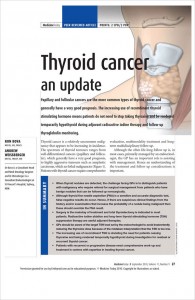The Thyroid Gland is a butterfly shaped gland located in the lower neck just above the breastbone. It produces hormones (T3 and T4), which regulate your body’s metabolism. The pituitary gland which is located under the brain controls the thyroid gland by producing a hormone called Thyroid Stimulating Hormone (TSH).
Thyroid nodules & goitre
Thyroid nodules occur when part of the thyroid overgrows and forms a discrete lump (nodule) within the thyroid gland. Some useful facts about thyroid nodules include:
- They are very common. In fact 5% of adults have palpable thyroid nodules. Furthermore studies of normal healthy adults have revealed a prevalence of ultrasound detected nodules of about 30-50%
- 95% of thyroid nodules are benign
- Most patients with thyroid nodules have normal thyroid function (Normal TSH and T4 levels)
- The main reason to investigate a thyroid nodule is to determine if it is malignant
- The most important investigations are Ultrasound, thyroid function tests (blood tests- T3, T4, TSH) and Fine Needle Aspiration Biopsy. A thyroid nuclear radio-isotope scan is only indicated if your blood tests indicate you are overactive (decreased TSH, elevated T4)
- The cause of most thyroid nodules remains unknown.
- Thyroid nodules may be single or multiple (multinodular goitre).
- A goitre is simply an enlarged thyroid gland
Thyroid surgery
Thyroid surgery is sometimes advised for patients who have a variety of thyroid conditions including:
- Graves’ Disease
- Benign multinodular goitre
- Retrosternal goitre
- Toxic multinodular goitre
- Thyroid cancer- there are 4 main types of thyroid cancer
- Papillary carcinoma- most common
- Follicular carcinoma- common
- Medullary Carcinoma- rare
- Anaplastic carcinoma- very rare
Indications for thyroid surgery include:
- Thyroid cancer confirmed on needle biopsy
- Suspicious cells on a needle biopsy. It is not uncommon for a pathologist to report atypical cells and surgery is required to confirm the diagnosis
- Thyroid nodule/ nodules that are producing symptoms. Symptoms may include a lump sensation, tightness sensation, difficulty swallowing, discomfort or pain (occasionally pain may radiate to ear or jaw).
- A large nodule causing compression of the airway
- A nodule that is overactive causing hyperthyroidism (Autonomous adenoma)
- A retrosternal goitre -where the thyroid enlarges downwards behind the breastbone and starts to fill the mediastinum (upper chest cavity)
- An enlarged thyroid that is cosmetically displeasing to the patient
- Graves Disease that is difficult to control with anti-thyroid medication
- Graves disease – as an alternative to radioactive iodine
Surgery to remove the whole thyroid is called a Total Thyroidectomy. Removal of half the Thyroid Gland is called a Hemithyroidectomy or Thyroid Lobectomy.
Please see Dr Bova’s article, published in Medicine Today, on Thyroid Cancer for further information.
Useful Links
The American Thyroid Association Website: www.thyroid.org
Dr Bova’s article, published in Medicine Today, on Thyroid Cancer: Download Article
Improving voice outcomes after thyroid surgery
As an ENT surgeon I am acutely aware of the impact that voice change can have on a person’s work and quality of life.
The thyroid and parathyroid glands are located very close to the nerves that control movement of the vocal cords (recurrent laryngeal nerves).
Avoiding injury to the recurrent laryngeal nerves is paramount during thyroid and parathyroid surgery. Minimising damage to these nerves is achieved by a combination of:
- Surgical experience
- Meticulous surgical technique
- Use of loupe (magnification) with a headlight to enhance visualisation
- Routine pre-op and post-op vocal cord assessment using a state of the art fibre optic nasendoscope.
- Routine use of intraoperative nerve integrity monitoring for all thyroid and parathyroid procedures.

